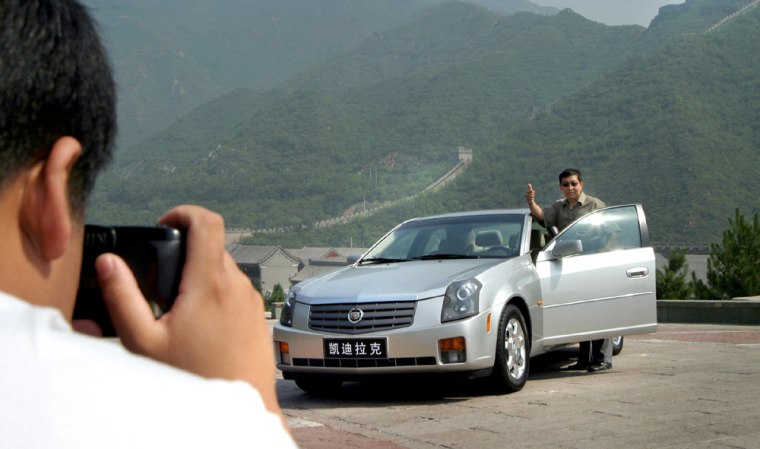Wang Qishun was all smiles as he watched a stream of gleaming cars pull into his drive-in cinema one recent moonlit evening. "The idea is from America, and, like America, China will also enter the auto age," he said, explaining his decision to set up a drive-in movie theater on a wooded northeastern edge of Beijing in 1998.
"The young generation of China is seeking modernity, and watching movies from inside the car, with all its comforts and privacy, is a sign of modernity," he said. "Now, I have a very stable business," Wang added.
Backed by government strategy and consumer demand, the stage is set for China's auto revolution, a historic shift of image for a country known as the kingdom of bicycles.
The explosive growth of China's auto industry in recent years has not only tantalized the world's auto giants — which have already poured in more than $30 billion in investments, with billions more to come — it has also stirred debate about how the world's environment and energy supply could cope with the motorization of a nation of 1.3 billion.
"The car used to be a viewed as a tool of production; but now, owning a car is a way of life, a necessity of life," said Huang Zhihui, a Beijing television producer.
This week, Beijing holds the biggest auto show ever staged in China. "It used to be that many companies would not come even if we invited them to our previous auto shows," said Qie Xiaogang, a veteran analyst at Beijing's largest auto market. "But for this show, many wanted to join even if we could not extend the invitation due to limited space."
China's allure
China’s car sales surged 40 percent and raced past the one million mark for the first time in 2002, and then nearly doubled to almost 2 million last year, with a projected 2.6 million output this year, a phenomenal rate of growth that has pushed it to overtake Germany as the world's third biggest auto market, after the United States and Japan.
Leading the charge into the China market is the world's number one producer, General Motors, which just announced a new $3 billion investment over three years, with the aim of doubling its yearly output from over half a million to 1.3 million units by 2007.
GM's move will pit it against Europe's leading producer Volkswagen, which also aims to increase its China output to 1.6 million units in the same time frame. Volkswagen, which enjoys a leading 33 percent market share in China, now sells more cars in China than it does in its home market of Germany.
Playing a cautious catch-up strategy, the U.S. number two producer Ford recently announced over $1 billion new investment in China with the aim of tripling output. DaimlerChrysler has also signed a $1.23 billion deal with a Beijing partner and rivals Toyota, Nissan, Honda and Hyundai have announced new investments of $10 billion as well.
The threat of overcapacity, and the specter of a future price war, has led China's Xinhua news agency to warn that output will exceed market demand by 20-25 percent in the next two to three years.
Bullish market
"Actually, the explosion of demand in the last two years was a very special temporary phenomenon," said Qie Xiaogang, the auto analyst. "China is still a low-income country and effective demand is limited, with annual growth rate of 10 to 15 percent, not 40 or 80 percent, more normal and sustainable," he added.
However, GM remains bullish in its belief that China will replace Germany as its second biggest market this year.
GM reported a quadrupling of its first-quarter net profits to $162 million, from last year's $44 million, and China appears to be on track to contribute 20-25 percent of GM's total global projected profit of $4 billion.
GM earned more from its Asia-Pacific operations, mostly from China, than from its traditional home base of North America in the third quarter of last year.

"It is feeling like the great gold rush," remarked GM's chief executive Rick Wagoner to a Swiss-American Chamber of Commerce assembly in Geneva earlier this year.
Wagoner predicted China would surpass Japan as the second biggest auto market in the world in five years' time at most, with a "reasonable chance" of overtaking the U.S. in his lifetime.
GM's current estimate is that some 74 million Chinese families, or 20 percent of the population, can afford to buy cars.
China's huge potential is also seen in the fact that only 20 people per 1,000 own cars, compared with 120 per 1,000 globally. While the United States. has 200 cars per 100 households, there is only one per four homes in major cities here like Beijing or Chengdu.
For GM, with its expertise in car finance, there are huge opportunities for growth as only some five to ten percent of car sales are backed by auto loans. China's auto loans could surpass 40 percent by decade's end, while 60-80 percent is the norm in developed countries, analysts said.
Potential pitfalls
One big question mark is the impact of China's current efforts to cool down its overheating economy, which grew more than nine percent last year and a further 9.7 percent in the first quarter this year, rates many economist consider unsustainable.
And another sign of trouble: rising rate of defaults on auto loans. China's laws have not yet created the "repo man," the process for the repossession of cars used as collateral for the debt.
According to various reports, banks have freely provided loans, estimated at some $4 billion in the first half of last year, but many customers have disappeared or simply abandoned their cars to buy something newer and cheaper, leaving insurers at the receiving end.
Appetite for oil might prove too great
The greater challenge with global ramifications involves China's increasing appetite for imported oil, which hit a world market price of $41.85 per barrel recently, a 21-year high.
The one million cars in China in 1990 ballooned to 24 million by the end of 2003, and could reach 57 million by 2010, and 130 million by 2020, according to experts' projection, a rate of growth faster than the United States, which motorized itself in the course of 60-70 years.
China, which became a net oil importer in 1993 and last year supplanted Japan as the second biggest importer of oil, will have to increasingly depend on imports for its oil demand that is expected to reach 400 million tons by 2010 and 600 million tons by 2020, according to experts.
"China last year became the second largest oil consumer after the U.S. and accounted for 60 percent of incremental global oil trade," according to research presented by Dr. Kelly Sims Gallagher of Harvard University's John F. Kennedy School of Government.
China's demand grew by nine percent last year to 270 million tons, a doubling since 1992, and as domestic production has remained static at around 170 million tons, the shortfall was covered by imports, mostly from the Middle East.
"China imports more than 100 million tons of oil every year because everybody wants to drive a car," said Shi Dinghuan, top official of China's Ministry of Science and Technology.
According to some theoretical projections, if China were to have the same number of cars per person as in the United States, it will eventually have to burn 24.8 million barrels of oil everyday, virtually the entire current production of the Organization of Petroleum Exporting Countries (OPEC).
Environmental impact
Experts have warned that vehicle emissions have now become the largest source of urban air pollution and the State Environment Protection Administration warned that motor exhausts will account for 79 percent of total air pollution in China next year.
China's emission standards are at least a decade behind those of the United States and Europe. Of the world's most polluted cities, seven are in China, thus the contention of conservationist Katherine Ellison that China is now becoming "the land of the rising smog."
China's roads have also become the deadliest in the world. According to a study conducted by Jinan University in Guangdong province, about 300 people are killed every day in traffic accidents, which is increase of approximately 10 percent annually.
Last year, more than 100,000 died in traffic related incidents, the highest national death toll in the world. Three-fourths of traffic accidents are accounted for by the deadly interplay of cars and bicycles on China's congested roads.
From 1990 to 2001, China's highways were lengthened by 30 percent, ranking it now behind the U.S., but in the same period, the number of vehicles has quadrupled.
Cars now only reach the speed of 6.9 miles per hour on average during rush hours in Beijing, where the current 2 million cars are increasing by a thousand a day and will reach 3.5 million by the time of the 2008 Olympics.
